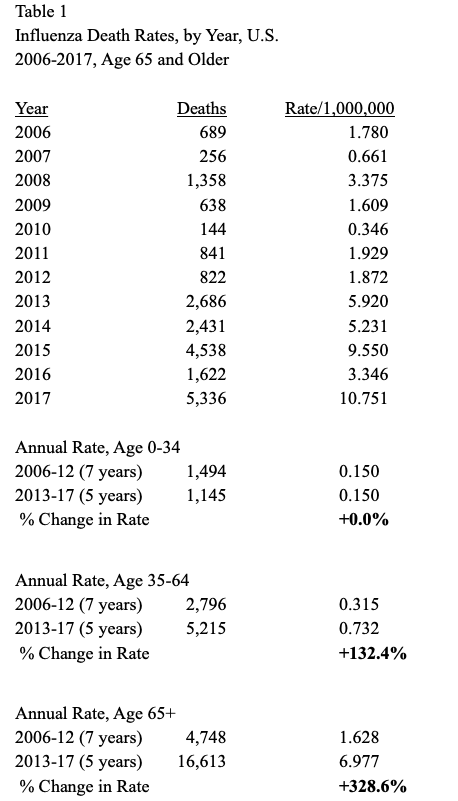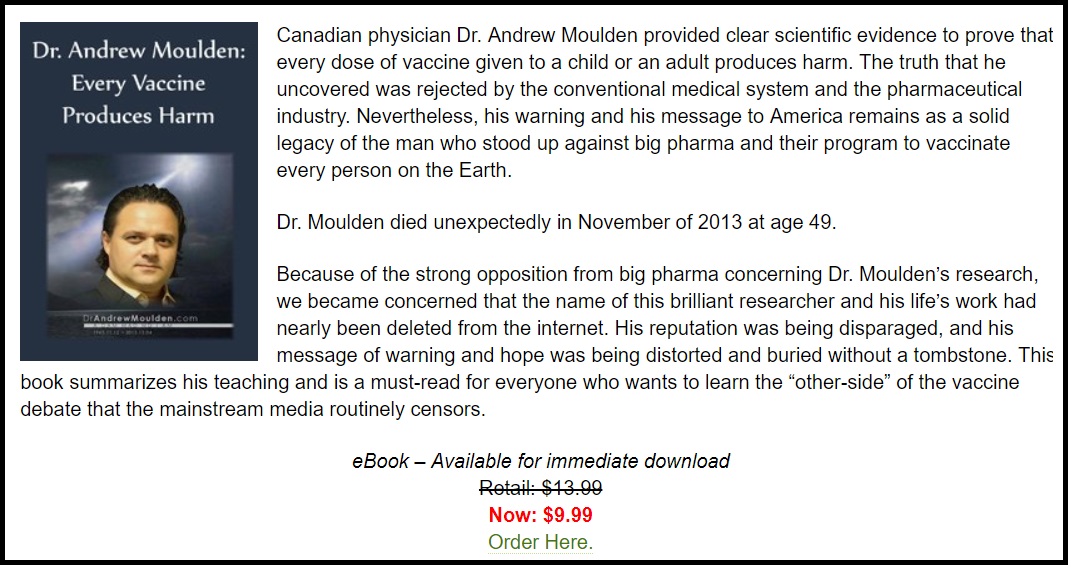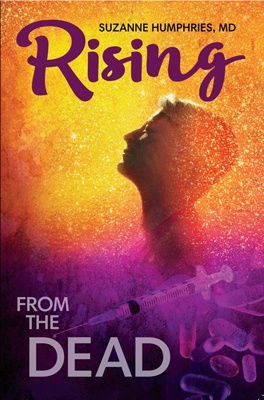
A typical pharmacy sales promotion for the flu vaccine targeting seniors during a past flu season.
by Health Impact News Staff
Flu shots have been offered to Americans for years. A major target from drug companies who make vaccines and physicians who administer them has been the elderly, who are more likely to develop the flu due to their declining health.
In addition, Medicare covers the cost of flu shots, making them more accessible to seniors.
On December 23, 2009, the U.S. Food and Drug Administration (FDA) approved use of Fluzone High-Dose flu vaccine for the elderly. This new product is four times more powerful, that is, it contains four times the amount of flu virus antigen per dose as the product used previously (Fluzone). The vaccine is given as a single injection.
FDA approval was given even though its Advisory Committee on Immunization Practices made no indication it was better than the previously-used Fluzone after reviewing studies of safety and effectiveness. The Centers for Disease Control and Prevention stated,
“Data demonstrating greater protection against influenza illness after vaccination with Fluzone High-Dose are needed to evaluate whether Fluzone High-Dose is a more effective vaccine for patients age > 65 years.”
The largest study reviewed by the FDA committee showed that the new high-dose vaccine had a 50% higher rate of side effects within the first week after the injection, and four times the chance that patients would develop fever after the shot.
The approval was given even though a large three-year study of effectiveness and safety had just begun (U.S. Centers for Disease Control and Prevention, 2010).
Almost immediately after FDA approval, questions were raised about serious side effects of the more potent new vaccine.
One of the first skeptics of Fluzone High-Dose was Dr. Joseph Mercola, who presented evidence that it increases side effects.
He referred to the manufacturer’s safety study that found a higher rate of serious adverse effects among elderly taking the high-dose flu shot (7.4%) than those who took the earlier flu shot (6.1%). The package insert lists these severe conditions (see Appendix).
In addition, Mercola cited a series of five recent analyses, called Cochrane reviews, on effects of the flu vaccine.
Each Cochrane review is not a single study but consists of multiple studies on the same topic.
One Cochrane review concluded there was no strong evidence that flu shots improved the health of the elderly, making higher-dose vaccinations a greater threat for a product that doesn’t work (Mercola, 2011):
“The available evidence is of poor quality and provides no guidance regarding the safety, efficacy or effectiveness of influenza vaccines for people aged 65 years or older.”
A 2012 article in Consumer Reports reported on whether the magazine’s panel of medical advisors advocate using high-dose Fluzone for the elderly, instead of the less potent vaccination.
The response was that the more potent Fluzone was NOT advised at any time, until proof of greater effectiveness was developed (Mitchell, 2012).
“Initially we hoped this high-dose vaccine might particularly help seniors who are very ill or have compromised immune systems, but given the lack of clinical trial data, and that there is a risk of making sick people even sicker, our medical consultants don’t advise it for anyone at this time. Until more is known about how protective the high-dose shot is for all seniors, the regular flu vaccine remains the best option.”
Also in 2012, a Scientific American article cast doubt on whether the new, strengthened flu vaccine could protect the elderly.
It cited a 2006 journal article by the Group Health Research Institute in Seattle that showed vaccinated seniors were 44% less likely to die than unvaccinated seniors were during flu season, but 61% less likely to die before flu season even started.
This raises the question of whether healthier elderly people are more likely to elect to have a flu shot.
Furthermore, the fact that vaccinated elderly persons are 61% less likely to die from flu in the non-flu season (compared to just 44% less during flu season) raises the possibility that taking the vaccine may worsen an elderly person’s chance of surviving flu season (Moyer, 2012).
A study of nearly 32,000 nursing home patients showed that fewer elderly persons taking the high-dose flu shot developed the flu than did those taking standard doses (1.4% vs. 1.9%).
Those in the high-dose group also had a lower rate of serious side effects (8.3% vs. 9.0%). All six persons who died within 30 days of taking the vaccine were given high doses, but authors believe that these deaths had nothing to do with the flu shots (DiazGranados, 2014).
After FDA approval of the high-dose flu shot for the elderly, use of the new vaccine began slowly. In the period 2010-2012, the first three years after approval, just 18.4% of elderly Americans receiving flu shots received the high-dose version (McGrath, 2015). The numbers of 25% and 32% in 2011 and 2012 likely means a much larger percent in years after.
One important way to test for any effect that High-Dose Fluzone had on elderly Americans is to review death rates in the periods before and after it was introduced. The CDC maintains a database of all deaths of U.S. residents; in mid-2019, the database covered all years from 1968-2017.
Table 1 is a comparison of influenza deaths for the periods 2006-2012, when less than 10% of elderly Americans vaccinated for the flu had High-Dose Fluzone, and 2013-2017, when a much larger (but unknown) percent of those vaccinated were given High-Dose Fluzone (Centers for Disease Control and Prevention, 2019).
Prior to 2013, fewer than 1,000 elderly Americans died from the flu in all but one year. But in the most recent five years available, the average jumped to over 3,000 per year, exceeding 5,000 in the most recent year (2017). The 2013-2017 flu death rate among Americans over 65 jumped 328.6%, or more than four times than it was in the period 2006-2012.
The influenza death rate did not change among Americans age under 35, while it rose 132.4% (more than doubled) among those age 35-64.
Additional information may be pertinent to this unusual trend:
- Large increases in elderly flu death rates occurred among all major racial and ethnic groups (white, black, Hispanic, and Asian).
- Large increases occurred for both elderly males and females.
- Increases occurred for elderly in all but two small states (Delaware and Nevada). The highest increase was reported in Oregon, where the 2013-2017 rate was nine times greater than earlier.
Possible causes for this increase, each of which do not explain the recent trend, are listed:
- “The flu was stronger” in the past five years. False. Younger age groups were not affected, and other periods of high flu deaths (1968-1969, 1980-1981, and 2006-2007) affected all age groups, not just the elderly.
- “It’s a coding change” starting in 2013. False. No such federal rules affecting coding of flu deaths were issued.
- “The elderly had to die of something.” False. The death rate for all causes among U.S. elderly declined 5% from 2006-2012 to 2013-2017, compared to the 328.6% rise for the flu.
- “Fewer people were immunized.” False. Roughly 40% of Americans over six months receive the (recommended) flu vaccine annually, a number that does not vary much year by year.
- “Not that many people were affected.” False. The total number of flu deaths among U.S. elderly in the past five years (16,613) is large, and trends are statistically significant.
One suggestion that greater use of High-Dose Fluzone is associated with this large jump is by comparing elderly flu death rates for 2006-2010 (when it was not used), and in 2011-2012 (when it was used in 25% – 32% of elderly receiving flu shots). The rate increased 24%, from 1.542 to 1.912 deaths per million persons, during this time. Presumably, the proportion of elderly flu shots using High-Dose Fluzone rose after 2012, as the flu death rate from soared to 6.977.
Some experts participating in the dialogue on vaccine safety contend that flu shots cannot give someone the flu, or cause anything more than minor side effects.
In 1986, federal legislation enacted the National Vaccine Injury Compensation Program, giving families of immunized children a means of compensation for the harm caused by vaccines, while absolving drug companies from any fault.
A total of 6,358 claims have been compensated at a total of $4 billion. Two-thirds of these claims involved flu vaccines (Health Resources and Services Administration, 2019).
The new High-Dose Fluzone is made of inactivated influenza virus, and thus cannot “give” vaccinated persons any of the three types of flu virus that the product protects against. But types of flu are difficult to predict before the season starts, as manufacturers prepare millions of doses of vaccine, and flu shots in a given year often do not protect against the actual strain or strains (Janjua, 2010).
When a flu shot is given, the antigens it contains generate antibodies against disease. These antibodies are “fighters” the body uses against multiple diseases, even though it protects only against the types of flu it is made to prevent.
Antibody attacks could reduce the body’s immune system strength, which is already lowered in elderly persons. Thus, a flu shot four times more powerful than the one it replaced could, theoretically, cause higher rates of disease (Angelantoni, 2017).
The recent mortality rise in elderly flu deaths should be taken seriously, and future trends should be monitored by health officials. More studies are needed comparing rates of flu deaths among those who have been vaccinated with High-Dose Fluzone, vaccinated with normal dose Fluzone, those immunized using flu mist, and those who are not vaccinated, to better explore ways to provide maximum safety for elderly persons.
About the Author
The author is a freelance writer for Health Impact News who is an epidemiologist and has published over 30 articles in medical journals. Due to the risks involved in today’s climate for anyone who dares to publish anything questioning vaccines, this person wishes to remain anonymous to protect their family and career.
References
Angelantoni A. Why do people get the flu after getting the flu shot? Medium, September 30, 2017. https://medium.com/@andreangelantoni/there-are-several-significant-errors-the-doctor-includes-in-her-article-6dfc196afd9b.
DiazGranados CA, Dunning AJ, Kimmel M, et al. Efficacy of High-Dose versus Standard-Dose Influenza Vaccine in Older Adults. N Engl J Med. 2014;371:635-645.
Health Resources and Services Administration. Monthly Report on Vaccine Compensation, February 4, 2019. https://www.hrsa.gov/sites/default/files/hrsa/vaccine-compensation/data/monthly-stats-february-2019.pdf.
Janjua NZ, Skowronski DM, Hottes TS, et al. Seasonal influenza vaccine and increased risk of pandemic A/H1N1‐related illness: first detection of the association in British Columbia, Canada. Clin Infect Dis. 2010;51(9):1017-1027.
McGrath LJ, Brookhart MA. On-label and off-label use of high-dose influenza vaccine in the United States, 2010–2012. Hum Vaccin Immunother. 2015;11(3):537-544.
Mercola J. Warn Your Friends and Family: The Fluzone High-Dose Vaccine is Dangerous. October 11, 2011. https://articles.mercola.com/sites/articles/archive/2011/10/17/dangerous-new-ineffective-flu-vaccine-released-for-seniors.aspx.
Mitchell S. Should Seniors Get the Fluzone High-Dose Flu Vaccine? Consumer Reports News, September 21, 2012. https://www.consumerreports.org/cro/news/2012/09/should-seniors-get-the-fluzone-high-dose-flu-vaccine/index.htm.
Moyer MW. Flu Shots May Not Protect the Elderly or the Very Young. Scientific American, October 18, 2012. https://www.scientificamerican.com/article/flu-shots-may-not-protect-the-elderly-or-the-very-young/.
U.S. Centers for Disease Control and Prevention. Licensure of a High-Dose Inactivated Influenza Vaccine for Persons Aged ≥65 Years (Fluzone High-Dose) and Guidance for Use — United States, 2010. Morbidity and Mortality Weekly Report, April 30, 2010.
https://www.cdc.gov/mmwr/preview/mmwrhtml/mm5916a2.htm.
U.S. Centers for Disease Control and Prevention. CDC Wonder, Detailed Mortality, 2019. https://wonder.cdc.gov/controller/datarequest/D76.
Appendix 1
Severe side effects reported by the manufacturer’s safety studies after flu shots for the elderly include:
Thrombocytopenia (low platelet count)
Guillain Barre syndrome, myelitis (spinal cord inflammation)
Optic neuritis (inflammation of the optic nerve)
Lymphadenopathy (enlarged lymph nodes)
Facial palsy/Bell’s palsy
Paresthesia (tingling/numbness of the skin)
Itchy skin
Anaphylaxis (life-threatening, whole-body allergic reaction)
Stevens-Johnson syndrome
Vasculitis (inflammatory destruction of blood vessels)
Difficulty breathing
Chest pain
Brachial neuritis (excruciating unilateral shoulder pain, followed by paralysis of shoulder)
Pharyngitis and rhinitis (inflammation of the throat or pharynx and the nose, respectively)
Convulsions, fainting, and dizziness.
Appendix 2
Flu codes and mortality rates:
Influenza deaths are identified in the CDC web site as persons whose cause of death started with certain codes from the International Classification of Disease, covering various revisions. These include 470 and 472-474 (8th revision, 1968-1978); 487 (9th revision, 1979-1998); and J9-J11 (10th revision, 1999-2017). Mortality rates are annual death rates, adjusted to the 2000 U.S. standard population.
Leaving a lucrative career as a nephrologist (kidney doctor), Dr. Suzanne Humphries is now free to actually help cure people.
In this autobiography she explains why good doctors are constrained within the current corrupt medical system from practicing real, ethical medicine.
One of the sane voices when it comes to examining the science behind modern-day vaccines, no pro-vaccine extremist doctors have ever dared to debate her in public.
-
Book – The Vaccine Court, by Wayne Rohde – 240 pages
“The Dark Truth of America’s Vaccine Injury Compensation Program”
FREE Shipping Available!
ORDER HERE!









One Comment